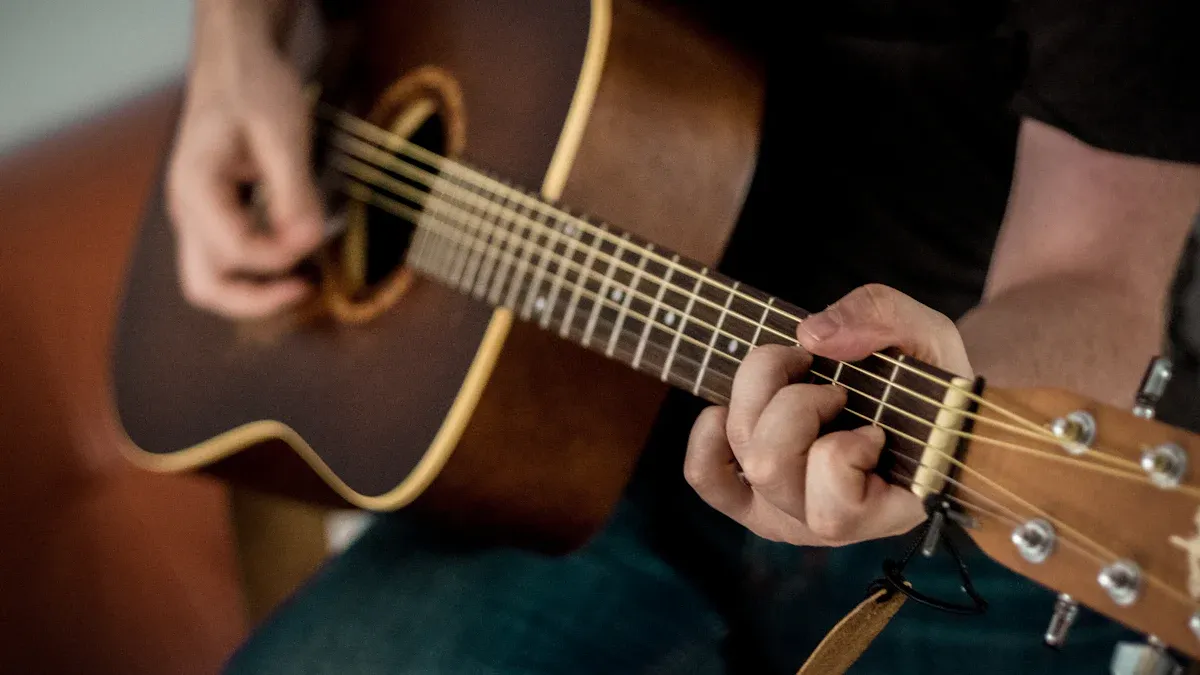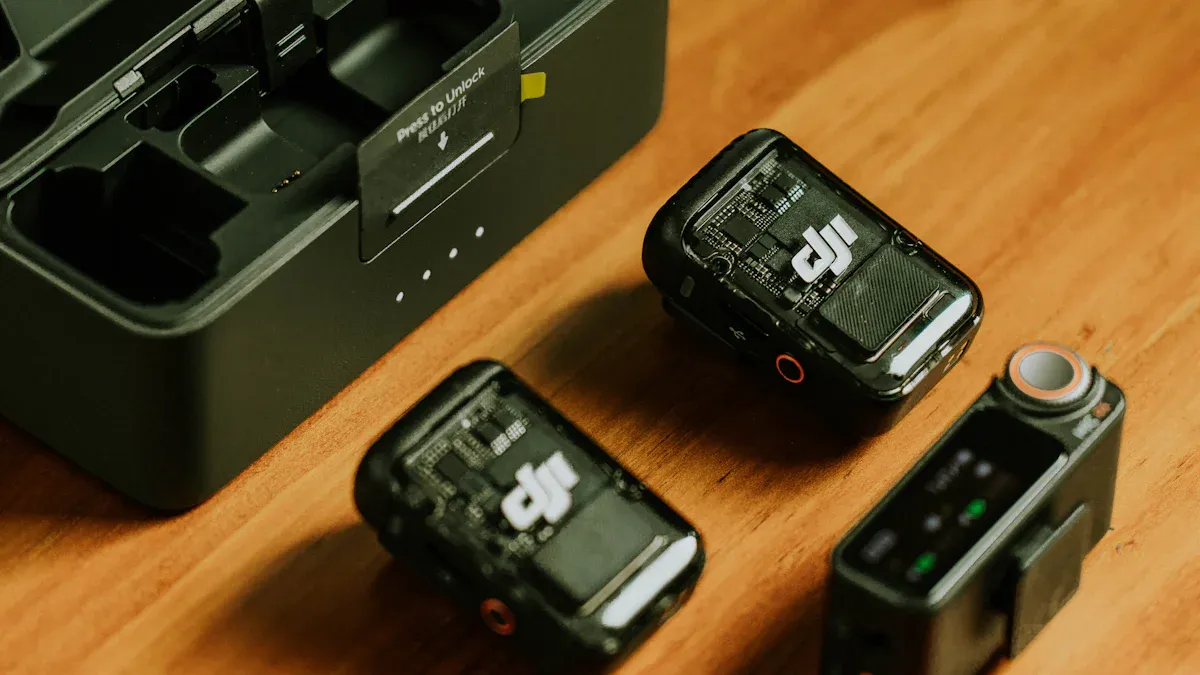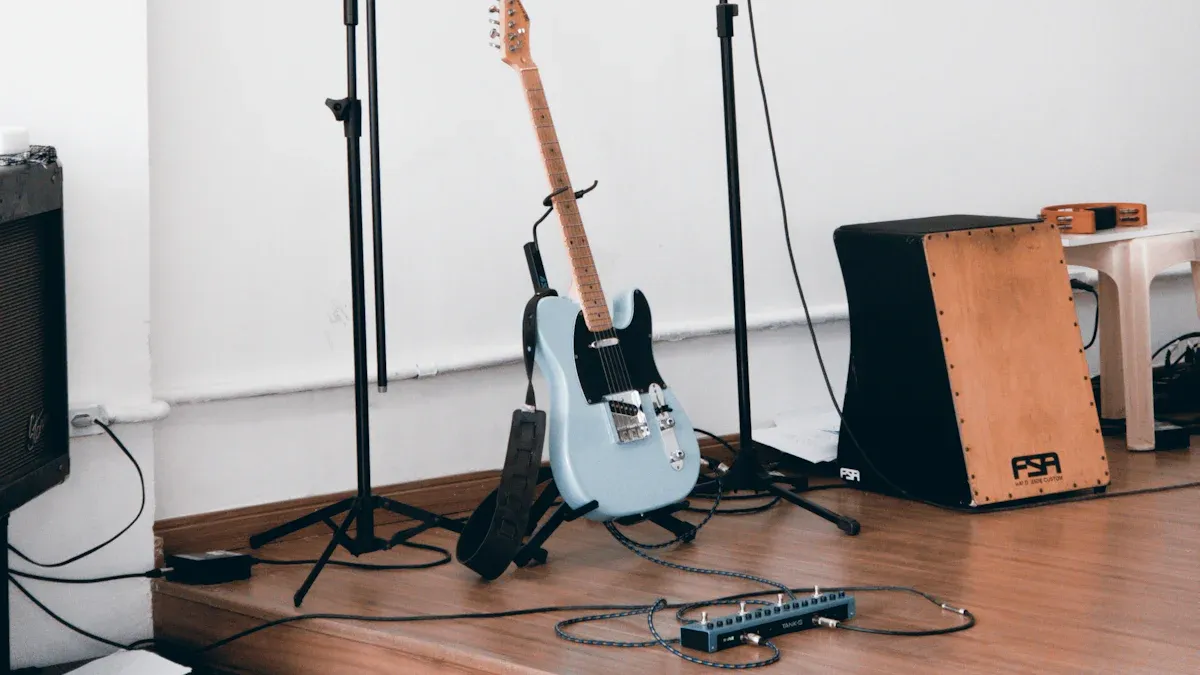
An active di box helps musicians get the best sound from their acoustic guitar. It takes the guitar’s signal and changes it so mixers and audio gear can use it. Many players pick an active di box because it keeps the sound clear and strong. The Musontek Active D.I. Box-AD1L is special because it can handle loud signals and cut down on noise.
Here’s why guitarists often pick an active di box:
Reason | المزايا |
|---|---|
Handles higher signal levels | No signal loss, sound stays the same |
Wide dynamic range (118dB) | No distortion, even when playing loud |
Ground lift switch | Gets rid of hum and other noise |
Some musicians compare the AD1L to a passive DI Box or even the Passive DI box PD1X, but the active features really make a difference. The AD1L is also different from the Active DI Box AD1F because it has its own special circuit design.
Key Takeaways
An active DI box makes the guitar sound louder and clearer. It helps the guitar sound good on stage and when recording.
The Musontek AD1L has a ground lift switch. This switch stops buzzing and noise. It helps the sound stay clean.
Active DI boxes have high input impedance. This keeps the guitar’s tone safe. It also stops the signal from getting weak. This is good for passive pickups.
Active DI boxes like the AD1L need phantom power. This means you do not need batteries. It makes setting up easier.
Using an active DI box helps the sound be clear and detailed. It is a helpful tool for musicians.
How active di box works

Signal Conversion: Converting High to Low Impedance
An acoustic guitar sends out a high-impedance signal. This signal is unbalanced and can lose quality. It can also pick up noise, especially with long cables. An active di box changes the signal to low impedance. The new signal is balanced and travels farther. It keeps the sound clear and stops unwanted noise.
The di box has a pre-amplifier that changes the signal.
It keeps the upper harmonics from passive pickups, so the guitar sounds real.
High input impedance, up to 1 megaohm, helps keep the guitar’s tone.
Impedance Matching: Ensuring Optimal Signal Transfer
Impedance matching helps get the best sound. The di box matches the guitar’s impedance to mixers or audio interfaces. This makes sure the signal moves well and stays strong.
The built-in preamp boosts the signal and gives more headroom.
This boost keeps the sound strong, even with long cables.
The active circuit gives a wider frequency response, so it works for many instruments.
Here’s a quick look at how the Musontek AD1L stands out:
المواصفات | موسونتيك AD1L AD1L | PD1L Passive DI Box |
|---|---|---|
معاوقة الإدخال | 1MΩ | 10 كيلو أوم |
التشوه التوافقي الكلي (THD) | 0.002% | 0.008% |
النطاق الديناميكي | 118 ديسيبل | 128 ديسيبل |
استجابة التردد | ±0.2dB (20Hz-20kHz) | ±0.3dB (20Hz-20kHz) |
The Musontek AD1L uses a special circuit and a Class A buffer. These help keep the sound clear and detailed.
Power Source: Active DI Box Requires Power
An active di box needs power to work. Most get power from 48V phantom power from a mixer or audio interface. This means players do not need to use batteries. The power helps the di box keep the signal strong and clean.
Tip: Always check if your mixer or interface gives phantom power before using an active di box.
Benefits of active di box for acoustic guitar
Sound Quality: Enhanced Clarity and Detail
Musicians want their acoustic guitar to sound clear. They also want it to sound natural. An active di box helps make the sound better. It boosts the signal and keeps the guitar’s tone strong. The Musontek AD1L has a special circuit and a Class A buffer. These help the di box give rich sound with very little distortion. Players hear more detail and clarity in their music.
The di box keeps the upper harmonics from passive pickups.
High input impedance (1M Ohms) protects the guitar’s tone.
Wide dynamic range lets players play loud without losing sound quality.
Here’s how input impedance helps:
معاوقة الإدخال: | 1 ميجا أوم، غير متوازن |
|---|
High input impedance keeps the signal strong.
It stops loading effects, which matter for passive pickups and loud signals.
Noise Reduction: Minimizing Hum and Interference
Noise can mess up a good performance. Hum and interference come from long cables or bad connections. An active di box helps stop these problems. The Musontek AD1L has a ground lift switch. This switch removes hum by breaking ground loops. Players use the phase reverse feature to fix phase problems when mixing signals.
الميزة | المزايا |
|---|---|
Ground lift switch | Gets rid of noise by stopping ground loops, making sound better. |
Phase reverse | Helps avoid phase problems when mixing DI signals with miked outputs. |
High-pass filtering | Cuts out low-end ‘mud’ in the mix, making the sound clearer. |
Dual inputs | Lets players mix signals from stereo sources, giving more options for setups. |
Footswitch output muting | Makes it easy to change guitars without extra noise in the mix. |
Tip: Players can use the ground lift switch to fix hum fast during a show.
Compatibility: Works with Various Audio Equipment
A good di box works with lots of audio gear. The Musontek AD1L connects to mixers, audio interfaces, and amps. Its chain port lets players send the signal to pedals or amps. This makes it easy to set up the acoustic guitar for any event. The di box works for both live shows and studio recording.
Chain port lets players send the signal different ways.
Dual inputs help mix signals from more than one source.
Footswitch output muting lets players switch guitars quietly.
Musicians trust the Musontek AD1L for its sound and features. They use it to get great acoustic sound on stage and in the studio.
Active di boxes vs passive di box
Key differences
Players see two main types of di boxes. These are active and passive. Each type works best for certain needs. Active di boxes use power to make the signal stronger. Passive di boxes do not need power. They use a transformer to change and balance the signal. Passive di boxes are simple and work well. Players like passive di boxes for loud instruments. These boxes handle strong signals without making the sound bad.
Here is a table that shows which di box fits each instrument:
Instrument Type | Recommended DI Box Type |
|---|---|
High-output instruments | Passive DI boxes |
Low-output instruments | Active DI boxes |
Active di boxes are good for direct connections. They work well with electric guitars and mixing desks. They keep the signal strong. Passive di boxes are best for acoustic guitars with built-in preamps. They also work for guitars that send out high signals. Passive di boxes do not need batteries or phantom power.
Why choose active di box
Active di boxes are great for acoustic guitars with passive pickups. These pickups send out weak signals. The active di box has a preamp circuit. It boosts the signal and keeps it clear. Musicians can control their sound better, especially in studios. The Musontek AD1L gives a flat frequency response and wide dynamic range. It also helps reduce noise. It picks up every detail, no matter how hard or soft you play.
Active di boxes have extra features. Players can change EQ settings and use ground lift switches. These help cut noise. The AD1L is a good choice for live shows and recording.
Tip: If you play an acoustic guitar with passive pickups, use an active di box like the Musontek AD1L. It keeps your sound strong and true.
When passive di box works
Passive di boxes are best for loud instruments. If your acoustic guitar has a built-in preamp, use a passive di box. It handles strong signals easily. Players pick passive di boxes when they want something cheap or simple. Passive di boxes do not need power. They work anywhere. They balance the signal and help stop ground loops.
Musicians should choose the right di box for their setup. Active models like the Musontek AD1L have more features and control. Passive models are good for strong signals and simple needs.
Using a di box with acoustic guitar

Setup Steps: How to Connect Your Acoustic Guitar
Connecting an acoustic guitar to a direct box is easy if you follow these steps:
Lower the main fader on the mixer before plugging anything in. This keeps the speakers safe from loud pops.
Take a 1/4″ TS cable and plug one end into the guitar’s output. Plug the other end into the high-impedance input on the di box.
Use an XLR cable to connect the balanced output of the di box to the mixing console or PA system.
Set the gain on the mixer so the signal does not get too loud or distorted.
Adjust the EQ on the mixer to get a clear and balanced sound.
Tip: Always double-check your cables and connections before turning up the volume.
Live and Studio Use: Versatility in Different Environments
A di box works well in both live shows and studio sessions. Players often use a direct box on stage to send a clean signal to the sound system. In the studio, they might use a di along with microphones to capture every detail of the acoustic guitar. This helps blend the natural sound of the guitar with the direct signal. Sometimes, the di sound helps keep the guitar and vocals separate, which makes mixing easier. Players may need to adjust the EQ, since a di can make the guitar sound a bit sharp on its own.
In studios, engineers often combine di and mic signals for a rich acoustic sound.
On stage, a di box helps avoid feedback and keeps the guitar signal strong.
The Musontek AD1L’s chain port lets players send their signal to amps or pedals, giving more options for creative setups.
Troubleshooting: Common Issues and Solutions
Many guitarists have questions about using an active di box. Some worry about noise or hum. The ground lift switch on the Musontek AD1L can fix most hum problems fast. If the signal sounds weak, check the cables and make sure the mixer gives phantom power. Players who perform often sometimes carry more than one di box, since venue gear can vary. Active di boxes like the AD1L offer more features and control, which helps in tricky setups.
Note: If you hear buzzing or lose signal, try swapping cables or using the phase reverse switch to solve the problem.
Features to consider in active di box
Sound Fidelity: Preserving Tonal Integrity
Musicians want their acoustic guitar to sound clear and real. A good active di box keeps the guitar’s tone the same. How well it is made is very important. The Musontek AD1L uses a special circuit and a Class A buffer. These parts help the box give rich sound with almost no distortion. Players can hear all the small details in their music.
Here’s a table that shows what to check for in build quality:
Consideration | الوصف |
|---|---|
High Voltage Handling | Handles strong signals from acoustic-electric guitars. |
Quality Transformers | Keeps the upper frequencies clear and avoids distortion. |
Wide Dynamic Range | Maintains the full sound of the instrument, even when playing loud. |
Bandwidth | Preserves harmonics above 20kHz for better sound. |
Spatial Localization | Helps the guitar stand out in the mix. |
A wide dynamic range and high input impedance keep the guitar’s tone strong. The Musontek AD1L has an input impedance of 1 megaohm and a dynamic range of 118dB. This is higher than what many other di boxes offer.
Input/Output Options: Versatility for Various Setups
Players need a direct box that works with many setups. The Musontek AD1L gives lots of ways to connect your gear. It works with mixers, amps, and pedals. The chain port lets you send the signal to different places. This makes it easy to use the di box on stage or in the studio.
Look at these common input/output features:
الميزة | الوصف |
|---|---|
Ground Lift | Breaks ground loops to reduce noise. |
Thru/Bypass | Sends the original signal to an amp or pedal, while the di sends a balanced signal to the mixer. |
Pad | Lowers the signal level for loud instruments, keeping the sound clean. |
The Musontek AD1L has these features, so players can set up their guitar any way they want.
Extra Functions: Additional Features for Enhanced Performance
Some active di boxes have extra tools for better sound. The Musontek AD1L has a ground lift switch to stop hum and noise. It also has a pad switch to lower the signal if needed. These features help players fix problems fast during a show or recording.
Here are some extra functions found in top di boxes:
Ground Lift: Gets rid of hum by breaking ground loops.
Pad: Makes the signal lower for line-level outputs.
Phase Reverse: Fixes phase problems when mixing signals.
Chain Port: Sends the signal to amps or pedals for more creative setups.
Players who want the best sound and more options pick a direct box with these features. The Musontek AD1L is special because it has strong build quality, smart input/output choices, and helpful extra functions.
An active DI box helps acoustic guitar players keep their sound clear and true. Many musicians use DI boxes in studios to capture the natural tone of their instruments. The Musontek AD1L stands out with its strong features and easy setup. Players should look at their own needs before upgrading.
Factor | Explanation |
|---|---|
مطابقة المعاوقة | Makes sure the guitar and DI box work well together for the best sound. |
Cable Run Length | Longer cables need a DI box to stop noise and keep the signal strong. |
Pickup System Needs | Some guitars need special DI box features to sound their best. |
Choosing the right DI box can make every performance or recording sound better.
FAQ
What does an active DI box do for acoustic guitar?
An active DI box boosts the guitar’s signal and changes it to balanced. This helps the sound stay clear and strong. Players use it to connect their guitar to mixers or audio interfaces.
Does the Musontek AD1L need batteries?
No, the Musontek AD1L gets power from 48V phantom power. Mixers or audio interfaces supply this power. Players do not need to worry about battery changes.
Can you use an active DI box for live shows and recording?
Yes! Musicians use active DI boxes like the AD1L on stage and in studios. The box keeps the sound clean and helps avoid noise. It works well for both settings.
How does the ground lift switch help?
The ground lift switch stops hum and unwanted noise. Players flip the switch to break ground loops. This makes the guitar sound better and cleaner.
Tip: Always check the ground lift switch if you hear buzzing or hum during a performance.